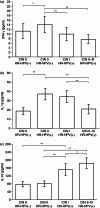Increased expression of programmed death (PD)-1 and its ligand PD-L1 correlates with impaired cell-mediated immunity in high-risk human papillomavirus-related cervical intraepithelial neoplasia
- PMID: 23521696
- PMCID: PMC3719068
- DOI: 10.1111/imm.12101
Increased expression of programmed death (PD)-1 and its ligand PD-L1 correlates with impaired cell-mediated immunity in high-risk human papillomavirus-related cervical intraepithelial neoplasia
Abstract
Impaired local cellular immunity contributes to the pathogenesis of persistent high-risk human papillomavirus (HR-HPV) infection and related cervical intraepithelial neoplasia (CIN), but the underlying molecular mechanisms remain unclear. Recently, the programmed death 1/programmed death 1 ligand (PD-1/PD-L1; CD279/CD274) pathway was demonstrated to play a critical role in attenuating T-cell responses and promoting T-cell tolerance during chronic viral infections. In this study, we examined the expression of PD-1 and PD-L1 on cervical T cells and dendritic cells (DCs), respectively, from 40 women who were HR-HPV-negative (-) or HR-HPV-positive (+) with CIN grades 0, I and II-III. We also measured interferon-γ, interleukin-12 (IL-12) and IL-10 in cervical exudates. The most common HPV type was HPV 16, followed by HPV 18, 33, 51 and 58. PD-1 and PD-L1 expression on cervical T cells and DCs, respectively, was associated with HR-HPV positivity and increased in parallel with increasing CIN grade. The opposite pattern was observed for CD80 and CD86 expression on DCs, which decreased in HR-HPV+ patients in parallel with increasing CIN grade. Similarly, reduced levels of the T helper type 1 cytokines interferon-γ and IL-12 and increased levels of the T helper type 2 cytokine IL-10 in cervical exudates correlated with HR-HPV positivity and CIN grade. Our results suggest that up-regulation of the inhibitory PD-1/PD-L1 pathway may negatively regulate cervical cell-mediated immunity to HPV and contribute to the progression of HR-HPV-related CIN. These results may aid in the development of PD-1/PD-L1 pathway-based strategies for immunotherapy of HR-HPV-related CIN.
Keywords: cervical intraepithelial neoplasia; cytokines; human papillomavirus; programmed death-1; programmed death-1 ligand.
© 2013 John Wiley & Sons Ltd.
Figures




Similar articles
-
Nocardia Rubra Cell Wall Skeleton Up-Regulates T Cell Subsets and Inhibits PD-1/PD-L1 Pathway to Promote Local Immune Status of Patients With High-Risk Human Papillomavirus Infection and Cervical Intraepithelial Neoplasia.Front Immunol. 2021 Jan 20;11:612547. doi: 10.3389/fimmu.2020.612547. eCollection 2020. Front Immunol. 2021. PMID: 33552075 Free PMC article.
-
Expressions of programmed death (PD)-1 and PD-1 ligand (PD-L1) in cervical intraepithelial neoplasia and cervical squamous cell carcinomas are of prognostic value and associated with human papillomavirus status.J Obstet Gynaecol Res. 2017 Oct;43(10):1602-1612. doi: 10.1111/jog.13411. Epub 2017 Aug 17. J Obstet Gynaecol Res. 2017. PMID: 28833798
-
Programmed death-1 (PD-1) expression in cervical intraepithelial neoplasia and its relationship with recurrence after conization.J Gynecol Oncol. 2018 May;29(3):e27. doi: 10.3802/jgo.2018.29.e27. Epub 2018 Jan 29. J Gynecol Oncol. 2018. PMID: 29400020 Free PMC article.
-
The role of programmed death-ligand 1 (PDL-1) in high-grade cervical intraepithelial neoplasia (CIN2+) development and recurrence: A systematic review of literature about HPV-CIN2+-PDL-1 axis.Pathol Res Pract. 2024 Dec;264:155712. doi: 10.1016/j.prp.2024.155712. Epub 2024 Nov 6. Pathol Res Pract. 2024. PMID: 39522315
-
Research Progress of Immune Mechanisms Related to Persistent HPV Infection in CIN after Cervical Conization.Iran J Allergy Asthma Immunol. 2024 Oct 6;23(5):467-475. doi: 10.18502/ijaai.v23i5.16755. Iran J Allergy Asthma Immunol. 2024. PMID: 39586741 Review.
Cited by
-
COVID-19 can lead to rapid progression of cervical intraepithelial neoplasia by dysregulating the immune system: A hypothesis.J Reprod Immunol. 2022 Dec;154:103763. doi: 10.1016/j.jri.2022.103763. Epub 2022 Nov 9. J Reprod Immunol. 2022. PMID: 36399874 Free PMC article.
-
Roles of B7-H3 in Cervical Cancer and Its Prognostic Value.J Cancer. 2018 Jun 23;9(15):2612-2624. doi: 10.7150/jca.24959. eCollection 2018. J Cancer. 2018. PMID: 30087701 Free PMC article.
-
Positive Surgical Margin, HPV Persistence, and Expression of Both TPX2 and PD-L1 Are Associated with Persistence/Recurrence of Cervical Intraepithelial Neoplasia after Cervical Conization.PLoS One. 2015 Dec 1;10(12):e0142868. doi: 10.1371/journal.pone.0142868. eCollection 2015. PLoS One. 2015. PMID: 26624896 Free PMC article.
-
Response to Neoadjuvant Chemotherapy in Locally Advanced Cervical Cancer: The Role of Immune-related Factors.In Vivo. 2021 Mar-Apr;35(2):1277-1283. doi: 10.21873/invivo.12379. In Vivo. 2021. PMID: 33622931 Free PMC article.
-
Human Papillomavirus Cervical Infection: Many Ways to a Single Destination.Vaccines (Basel). 2022 Dec 22;11(1):22. doi: 10.3390/vaccines11010022. Vaccines (Basel). 2022. PMID: 36679866 Free PMC article.
References
-
- Insinga RP, Perez G, Wheeler CM, et al. Incident cervical HPV infections in young women: transition probabilities for CIN and infection clearance. Cancer Epidemiol Biomarkers Prev. 2011;20:287–96. - PubMed
-
- Mougin C, Mo L, Dalstein V. Natural history of papillomavirus infections. Rev Prat. 2006;56:1883–9. - PubMed
-
- Sheu BC, Chang WC, Lin HH, Chow SN, Huang SC. Immune concept of human papillomaviruses and related antigens in local cancer milieu of human cervical neoplasia. J Obstet Gynaecol Res. 2007;33:103–13. - PubMed
-
- Hebner CM, Laimins LA. Human papillomaviruses: basic mechanisms of pathogenesis and oncogenicity. Rev Med Virol. 2006;16:83–97. - PubMed
Publication types
MeSH terms
Substances
LinkOut - more resources
Full Text Sources
Other Literature Sources
Medical
Research Materials

